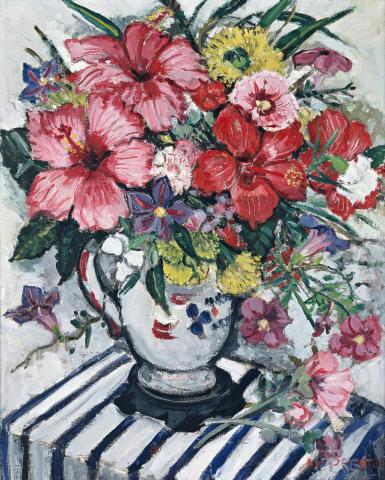MIXED FLOWERS, c.1925
Margaret Preston
oil on canvas
52.0 x 41.5 cm
signed lower right: M. PRESTON
W.G. Preston, the artist's husband, Sydney
Queensland Art Gallery, Brisbane, purchased 1943
Deutscher~Menzies, Melbourne, 29 November 2000, lot 27
Savill Galleries, Sydney
Private collection, Sydney
The mid-twenties are a particularly rich period for Margaret Preston's flower paintings, Mixed Flowers c1925 being of special appeal in a year noted for successes. It also presents one of Preston's favourite flowers, the hibiscus, which features in several of her outstanding works of the time. The major oil painting White and Red Hibiscus is in the collection of the Art Gallery of South Australia, Adelaide. Pink Hibiscus, which has some affinity with our painting, is in the Wesfarmers Collection, Perth; and there is the colour woodblock print Hibiscus, impressions of which are in the collections of the National Gallery of Australia, Canberra, and Victoria's Bendigo Art Gallery, and McClelland Gallery and Sculpture Park. All these works were produced in 1925. Other notable riches from that same year include one of Preston's best colour prints, Bird of Paradise. The National Gallery of Australia has the magnificent Still Life and flower painting Study in White, while another painting, Strelitzia in the collection of Melbourne's National Gallery of Victoria, adds further to these treasures. Each work shows much creative invention and diversity within what is in general Preston's more naturalistic style. Nevertheless, in addition to their independent qualities, each plays an important role leading up to her adventurous modernistic phase of 1927. Together they show why fellow artist Thea Proctor said of Preston, '...we have a distinguished and original artist in Australia - an artist with abundant vitality - the intellectual gift of invention and an emotional colour sense which amounts to genius.'1
Mixed Flowers is a characteristic painting from this period, employing strong, vibrant colours in the depiction of the flowers, their free flowing shapes offsetting perfectly the striped lines of the table cloth. The interaction and contrast between the two gives the painting its special dynamism, extended through the use of her characteristic compositional device of the high viewpoint. This increases the tension between the illusion of depth, created by the receding lines and angles of the table, and the emphasis on the picture's painterly rich surface of flowers. Through such means Preston's gives added power and directness to her visual statement, immediately engaging the viewer in its creative strengths and sensitivities.
1. Thea Proctor 1927, quoted in Edwards, D., Margaret Preston, Art Gallery of New South Wales, Sydney, 2005, p. 9
DAVID THOMAS
